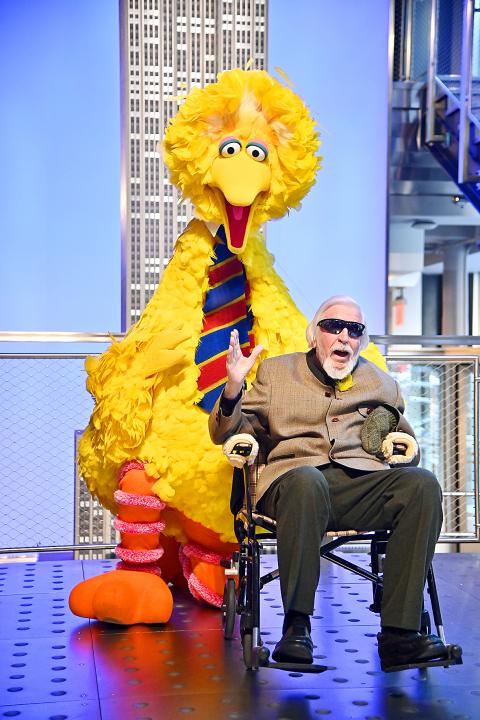Puppeteer Caroll Spinney, who brought Big Bird and Oscar the Grouch to life on the iconic children’s television show Sesame Street for half a century, died on Sunday at the age of 85.
Spinney died at home in Connecticut after living for some time with the movement disorder dystonia, which causes uncontrollable muscle contractions, according to a statement from Sesame Workshop, the nonprofit organization that produces the show.
The actor retired from the show last year, having hand-picked successors to play both Big Bird and Oscar — two very different characters he helped create, delighting millions of children. Those characters — one a towering yellow bird, the other a grumpy, green monster in a trash can — existed in what many considered a magical world created by puppet master Jim Henson and including pals Bert and Ernie, the lovable Cookie Monster and the goofy Kermit the Frog.

Photo: AFP
Spinney once told The New York Times he had modeled Oscar the Grouch on a cross between a “magnificently rude” restaurant waiter and a ranting New York cab driver.
In 1973, a year after then US president Richard Nixon made his dramatic trip to China, Spinney flew to Beijing for a performance dressed as Big Bird — he said he only paid half-price for the plane ticket because the character was only six years old.
When Henson died in 1990, Big Bird sang Kermit’s sweetly melancholy tune It’s Not Easy Being Green at a memorial service.
“Caroll was an artistic genius whose kind and loving view of the world helped shape and define Sesame Street from its earliest days in 1969 through five decades,” Sesame Workshop said in a statement.
“His enormous talent and outsized heart were perfectly suited to playing the larger-than-life yellow bird who brought joy to generations of children and countless fans of all ages around the world, and his lovably cantankerous grouch gave us all permission to be cranky once in a while.”
Poignantly, Spinney’s death came as the show marked its 50th birthday, and as it is lauded with one of America’s top cultural awards — the Kennedy Center Honors — at a gala Sunday in Washington.
Spinney himself won multiple Daytime Emmys for his work, as well as a Lifetime Achievement Award. He also earned a Grammy Award, for best children’s recording.
At the time of his retirement, he was quoted as saying that his Big Bird alter ego had “opened my mind and nurtured my soul.”
He hand-picked his successors in the two major roles — after mentoring them for more than two decades.
A shy child, Spinney embraced puppetry and reportedly owned 70 puppets by the age of 12. He met Henson at a puppeteers festival in 1962 and bumped into him again in 1969; months later, he joined Sesame Street.
Spinney’s life was the subject of the 2014 documentary I Am Big Bird: The Caroll Spinney Story.
Big Bird, the instantly recognizable giant yellow bird with the huge beak, is more than 250cm tall.
Spinney, who was 178cm tall, had to use his hands and wires to manipulate the towering puppet, guided by a TV monitor in the costume.
In 2000, he was named a Living Legend by the US Library of Congress, and he has a star on the Hollywood Walk of Fame.
Henson’s family said in a statement that Spinney managed to “perfectly convey the humor and heart in our father’s creations. Big Bird was childlike, without being childish. And Oscar the Grouch reflected universal feelings we all share, no matter our age.”
“That he could do this work so brilliantly, responsibly and with such infectious love and joy is his gift to us all,” the statement said.

Cheng Ching-hsiang (鄭青祥) turned a small triangle of concrete jammed between two old shops into a cool little bar called 9dimension. In front of the shop, a steampunk-like structure was welded by himself to serve as a booth where he prepares cocktails. “Yancheng used to be just old people,” he says, “but now young people are coming and creating the New Yancheng.” Around the corner, Yu Hsiu-jao (饒毓琇), opened Tiny Cafe. True to its name, it is the size of a cupboard and serves cold-brewed coffee. “Small shops are so special and have personality,” she says, “people come to Yancheng to find such treasures.” She

Late last month Philippines Foreign Affairs Secretary Theresa Lazaro told the Philippine Senate that the nation has sufficient funds to evacuate the nearly 170,000 Filipino residents in Taiwan, 84 percent of whom are migrant workers, in the event of war. Agencies have been exploring evacuation scenarios since early this year, she said. She also observed that since the Philippines has only limited ships, the government is consulting security agencies for alternatives. Filipinos are a distant third in overall migrant worker population. Indonesia has over 248,000 workers, followed by roughly 240,000 Vietnamese. It should be noted that there are another 170,000

Hannah Liao (廖宸萱) recalls the harassment she experienced on dating apps, an experience that left her frightened and disgusted. “I’ve tried some voice-based dating apps,” the 30-year-old says. “Right away, some guys would say things like, ‘Wanna talk dirty?’ or ‘Wanna suck my d**k?’” she says. Liao’s story is not unique. Ministry of Health and Welfare statistics show a more than 50 percent rise in sexual assault cases related to online encounters over the past five years. In 2023 alone, women comprised 7,698 of the 9,413 reported victims. Faced with a dating landscape that can feel more predatory than promising, many in

Former Chinese Nationalist Party (KMT) chairwoman Hung Hsiu-chu’s (洪秀柱) attendance at the Chinese Communist Party’s (CPP) “Chinese People’s War of Resistance Against Japanese Aggression and the World Anti-Fascist War” parade in Beijing is infuriating, embarrassing and insulting to nearly everyone in Taiwan, and Taiwan’s friends and allies. She is also ripping off bandages and pouring salt into old wounds. In the process she managed to tie both the KMT and the Democratic Progressive Party (DPP) into uncomfortable knots. The KMT continues to honor their heroic fighters, who defended China against the invading Japanese Empire, which inflicted unimaginable horrors on the